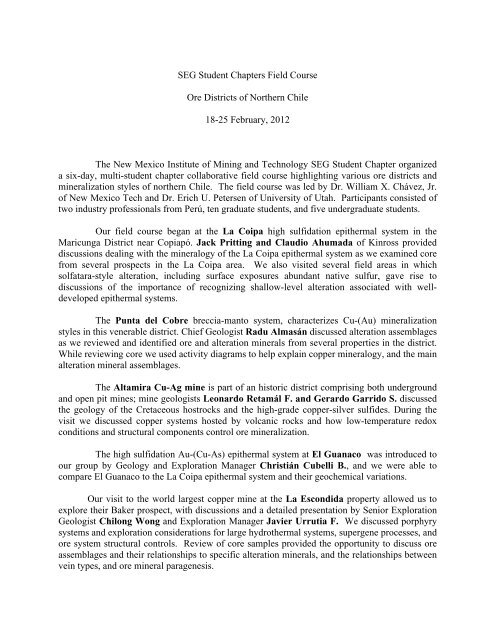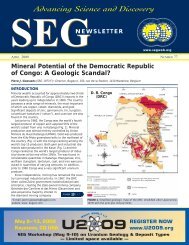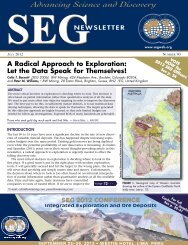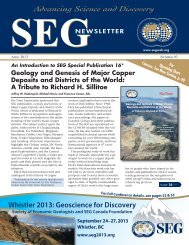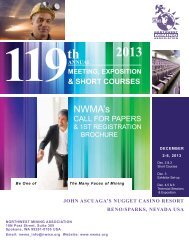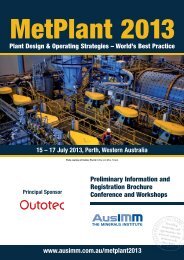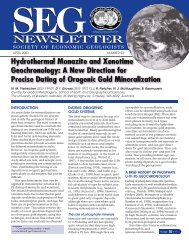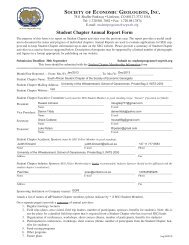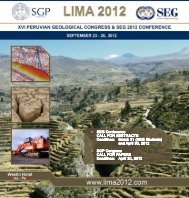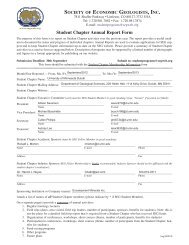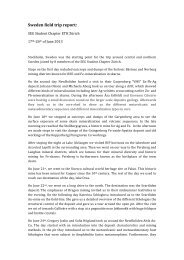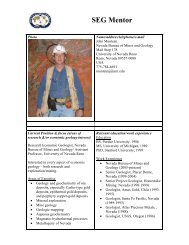NMT SEG Student Chapter Field Trip Report
NMT SEG Student Chapter Field Trip Report
NMT SEG Student Chapter Field Trip Report
You also want an ePaper? Increase the reach of your titles
YUMPU automatically turns print PDFs into web optimized ePapers that Google loves.
<strong>SEG</strong> <strong>Student</strong> <strong>Chapter</strong>s <strong>Field</strong> Course<br />
Ore Districts of Northern Chile<br />
18-25 February, 2012<br />
The New Mexico Institute of Mining and Technology <strong>SEG</strong> <strong>Student</strong> <strong>Chapter</strong> organized<br />
a six-day, multi-student chapter collaborative field course highlighting various ore districts and<br />
mineralization styles of northern Chile. The field course was led by Dr. William X. Chávez, Jr.<br />
of New Mexico Tech and Dr. Erich U. Petersen of University of Utah. Participants consisted of<br />
two industry professionals from Perú, ten graduate students, and five undergraduate students.<br />
Our field course began at the La Coipa high sulfidation epithermal system in the<br />
Maricunga District near Copiapó. Jack Pritting and Claudio Ahumada of Kinross provided<br />
discussions dealing with the mineralogy of the La Coipa epithermal system as we examined core<br />
from several prospects in the La Coipa area. We also visited several field areas in which<br />
solfatara-style alteration, including surface exposures abundant native sulfur, gave rise to<br />
discussions of the importance of recognizing shallow-level alteration associated with welldeveloped<br />
epithermal systems.<br />
The Punta del Cobre breccia-manto system, characterizes Cu-(Au) mineralization<br />
styles in this venerable district. Chief Geologist Radu Almasán discussed alteration assemblages<br />
as we reviewed and identified ore and alteration minerals from several properties in the district.<br />
While reviewing core we used activity diagrams to help explain copper mineralogy, and the main<br />
alteration mineral assemblages.<br />
The Altamira Cu-Ag mine is part of an historic district comprising both underground<br />
and open pit mines; mine geologists Leonardo Retamál F. and Gerardo Garrido S. discussed<br />
the geology of the Cretaceous hostrocks and the high-grade copper-silver sulfides. During the<br />
visit we discussed copper systems hosted by volcanic rocks and how low-temperature redox<br />
conditions and structural components control ore mineralization.<br />
The high sulfidation Au-(Cu-As) epithermal system at El Guanaco was introduced to<br />
our group by Geology and Exploration Manager Christián Cubelli B., and we were able to<br />
compare El Guanaco to the La Coipa epithermal system and their geochemical variations.<br />
Our visit to the world largest copper mine at the La Escondida property allowed us to<br />
explore their Baker prospect, with discussions and a detailed presentation by Senior Exploration<br />
Geologist Chilong Wong and Exploration Manager Javier Urrutia F. We discussed porphyry<br />
systems and exploration considerations for large hydrothermal systems, supergene processes, and<br />
ore system structural controls. Review of core samples provided the opportunity to discuss ore<br />
assemblages and their relationships to specific alteration minerals, and the relationships between<br />
vein types, and ore mineral paragenesis.


